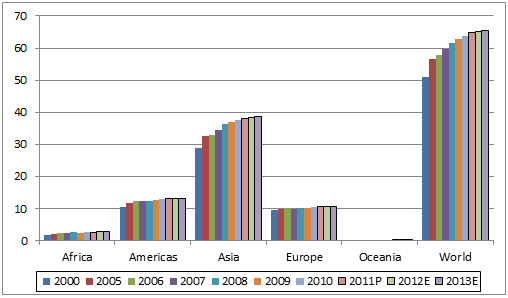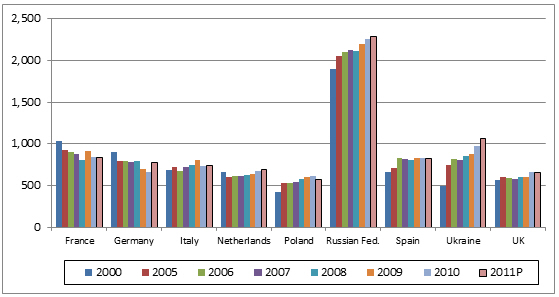



GLOBAL POULTRY TRENDS: Russia and Ukraine Produce One in Three of Europe's Eggs
Egg production in Europe overall has grown from around 9.5 million tonnes in 2000 to 10.6 million tonnes in 2011, according to industry analyst, Terry Evans. This expansion can be largely attributed to Russia and Ukraine as output from EU countries has increased negligibly.World egg production expanded by 1.2 million tonnes or a little less than two per cent in 2011, according to provisional data released by the Food and Agriculture Organisation (FAO). Increases were recorded throughout the regions but in particular the Americas, Asia and Europe. It should be noted however, that for many countries the data is unofficial and therefore, subject to revision.
Should this estimate prove correct and growth continues at that rate, then in 2013, world egg output (including hatching eggs which are estimated to be around five per cent of the total) could exceed 67 million tonnes. However, due to the difficult financial environment that has persisted worldwide over the past couple of years, it is likely that in many countries growth has, at best, been minimal and for some, production will have contracted. Hence, the actual total for 2013 is more likely to be between 65.5 and 66.0 million tonnes (Table 1 and Figure 1).
Looking at the period 2000 to 2011, while growth has occurred in all regions the slowest rate of expansion - one per cent a year - was in Europe. Indeed, as the more detailed figures presented in Table 2 reveal, while production in Europe as a whole is considered to have grown from 9.48 million tonnes to 10.64 million tonnes, the increase in the European Union (EU) showed an annual average gain of less than 0.2 per cent, underlining the point that Europe's expansion has been predominantly linked to expansion in the egg industries outside the EU. Indeed, EU table egg output is thought to have contracted by possibly two per cent in 2012 although a recovery of approximately this amount is anticipated in 2013.
While the total number of layers in Europe has increased from around 700 million in 2000 to 787 million in 2011, the number of birds in the EU has hardly changed at around the 480-million mark.

Although production in Europe expanded by almost 1.2 million tonnes during the review period, just two countries - Russia and Ukraine - accounted for some 956,000 tonnes or 83 per cent of this increase. Output in Russia, the largest producer in Europe, rose by a moderate 1.7 per cent a year, climbing from 1.9 million tonnes to about 2.3 million tonnes. In sharp contrast, production in Ukraine rocketed by more than seven per cent a year from a shade below 500,000 tonnes in 2000 to exceed one million tonnes in 2011. As a result, the EU's contribution to the Europe total has declined from around 70 per cent in 2000 to 64 per cent in 2011.
A report in September 2012 on the competitiveness of the EU egg industry by Peter van Horne of the Agricultural Research Institute at Wageningen in the Netherlands, revealed that, in 2010, the average production cost in Ukraine was some 79 per cent of that for the EU. However, although production costs in the EU have since increased by more than 15 per cent as the result of the implementation of European legislation on environmental protection, animal welfare and food safety, the high costs of transport and import tariffs have meant that Ukrainian eggs cannot compete on price within the EU. However, Ukraine is now in the list of authorised countries to export to the EU and this country might send eggs for breaking.
Although the banning of conventional cages in EU member states from 1 January 2012 caused market disruption, it was not as serious as some had predicted. While production declined in a number of countries, it is considered that the EUs level of self-sufficiency only slipped from 102 per cent to around 100 per cent. For 2013, a slight recovery is anticipated.
While the Russian Federation is easily the leading producer in Europe, accounting for more than one-fifth of the total in 2011 (Tables 2 and 3), Ukraine is quickly cementing its position in the number two spot in the production league. Back in 2000, Ukraine's egg industry was the eighth largest in Europe with production equating to little more than a quarter of that for Russia. By 2011, Ukraine was not only firmly established as the second largest producer in the region but its output was equivalent to almost 50 per cent of the Russian total.
Like in the other major egg-producing regions, only a relatively few countries account for the bulk of production. In Europe, the top nine countries - all producing more than 500,000 tonnes a year - had a combined output estimated at 8.5 million tonnes, or around 80 per cent of the regional total in 2011 (Table 4 and Figure 2). Not surprisingly, these nine countries also account for almost 80 per cent of the European human population.
Since 2000, the egg industry in Russia has expanded by a little less than two per cent a year as output has climbed to 2.3 million tonnes. While there may be some 160 million layers in the country, the commercial sector is considered to be around 140 million, all housed in cages, with the split between brown and white birds put at 50:50. Estimates of the number of eggs produced vary according to source but for 2011 it would appear to have been around 43 billion.
Most of production comes from the Volga Federal District with an estimated 10.3 billion eggs in 2010, followed by the Central Federal District with 8.2 billion and the Southern Federal District with 5.8 billion. According to Russia's agricultural analysis agency, Navigator, although there are some 450 large layer farms, possibly just 150 are operating at full capacity. That many farms are operating below capacity reflects the low levels of profitability as producers wrestle with rising production costs. While this is expected to slow industry growth, at least one report claims that the government intends stepping in to offer a level of financial support to offset rising electricity, fuel and feed costs.
Russia's largest egg producer, Borovskaya Poultry Farm ZAO, which was expected to produce one billion eggs in 2012, has become part of the Joint-Stock Company Bohr Poultry, based in Tyumen. Other leading egg producers are the Sverdlovsk Poultry Farm (846 million eggs), Roskar Farms (600 million) Agrosoyuz Holding and Lenptitseprom.
It is considered that the industry needs to put more emphasis into the production of egg products. One source claims that some seven per cent of eggs are further processed although others estimate this figure to be no more than four per cent.
Accession to the World Trade Organisation (WTO) is not expected to have a major impact on Russia's egg industry, as both imports and exports are small.

Egg production in Ukraine more than doubled between 2000 and 2011, when the number of eggs produced, according to FAO, amounted to around 18.4 billion was some nine per cent higher than in the previous year. All the flocks are housed in cages. While it is estimated that the industry has the capacity to process some four per cent of production, the actual quantity broken out is likely to be nearer two per cent.
AvangardCo IPL is the largest egg producer with a flock of 25.1 million at the end of 2011, which accounted for approximately 32 per cent of total production. In 2011, this company produced some 12,000 tonnes of dried egg, which represented about 87 per cent of the national total.
The remaining seven countries in the 'Top nine' (Table 4) are all members of the European Union. As mentioned earlier, production in the Community has hardly increased over the past decade. During this period, the industries in the two leading producers, France and Germany, have contracted sharply, while the others in this group managed to expand output, particularly Spain and Poland.
The contraction in Germany was the result of this country imposing the EU-wide ban on conventional laying cages a year earlier than the other member states. Back in 2005, according to an assessment by Professor Hans-Wilhelm Windhorst, the International Egg Commission's Statistical Analyst, more than 75 per cent of German layers were kept in conventional cages, 14 per cent in barns and 13 per cent on free range. By 2011, almost 63 per cent were housed in barns, 14.6 per cent on free-range, 14.6 per cent in colony nests and 7.3 per cent in organic systems.
Since 2002 Germany's level of self-sufficiency in eggs has fallen from 74 per cent to only 55 per cent in 2010. However, in 2011, as indicated in Table 4, the industry started to recover and self-sufficiency increased to 64 per cent and by late 2012, production was back to the pre-cage ban level. There is uncertainty as to how long production from colony cages will be permitted, underlined by leading German retailers deciding not to sell eggs from such systems. Current production from colony cages tend to be sold at farmers' markets and to egg processors. Clearly, this method of egg production will be phased out in Germany in the not-too-distant future.
Production in France slumped by some 200,000 tonnes a year, or approximately 20 per cent, between 2000 and 2011. The proportion of brown to white eggs in 2011 was put at 85:15. At that time, the proportion of the national flock housed in barns or on free-range was approaching 30 per cent compared with just 20 per cent a year earlier.
Between 2000 and 2006, the egg industry in Spain expanded by 26 per cent to reach 827,000 tonnes. The increase coincided with a sharp rise in exports. However, since then, output has stabilised somewhat around the 830,000 tonnes a year mark. Some 90 per cent of eggs are brown-shelled and even in 2011, only three per cent of the flock was housed in non-cage systems. The change from conventional to colony cages will have pushed up costs and brought about a cut-back in output. This has boosted prices such that egg processors have reported a shortage of supplies. Spain has about 57 egg processors producing some 110,000 tonnes of liquid product and 5,500 tonnes of powdered egg.
After peaking in 2009 at 813,000 tonnes, egg production in Italy has contracted, though estimates on the quantity vary. The industry is still feeling the impact of the animal welfare regulations, hence a further cut-back in production is more likely than a recovery. Between 2010 and 2011, the proportion of birds in non-cage systems jumped from 23 per cent to around 43 per cent. Only a small proportion of eggs are white, some 94 per cent being brown.
Egg production in the UK is estimated to have contracted by about four per cent in 2012. Over 50 per cent of eggs are not produced intensively. In that year, some nine per cent fewer eggs were purchased by processors and consequently, the volume of egg products declined to around 91,000 tonnes compared with more than 100,000 tonnes in 2011.
With the economic pressures principally due to the welfare regulations and feed costs that all EU egg producers are enduring, it seems unlikely that there will be a significant increase in output in the Community in the short-term.
April 2013












